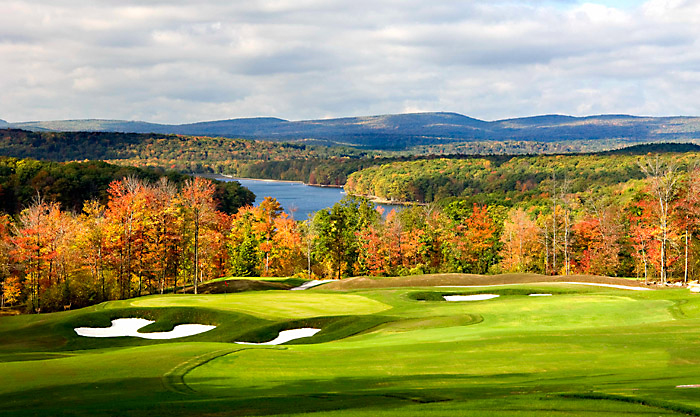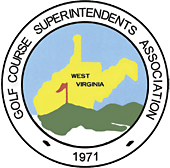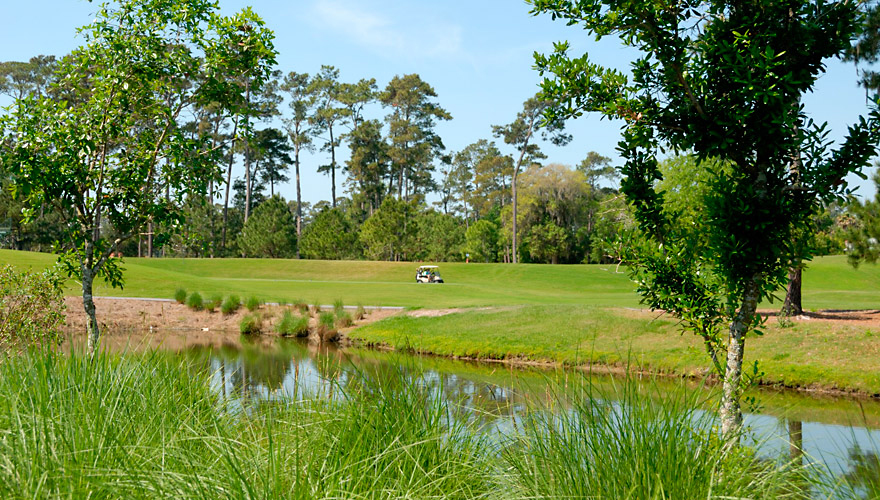Water Quality Monitoring and Management
Regulatory Considerations
Principle
Golf course owners and superintendents should investigate regulatory requirements that may exist in their location to protect surface and groundwater quality.
Best Management Practices
- Aquatic management of plants may be regulated under construction permitting and regulatory licensing requirements. Consult with federal, state, and local water management agencies before managing golf course lakes and wetland areas.
- Consult with federal, state, and local water management agencies, and/or consult an approved management plan before performing cultural practices: fertilization; installation of plants; hand removal of plants or mechanical harvesting.
- The introduction of aquatic triploid grass carp, biological controls, aeration, and chemical controls (herbicide/algaecide) must be approved and monitored according to permit and licensing protocols and compliance.
- The disposal of sediments from surface-water ponds (stormwater detention) may be subject to regulation.
- Golf course owners are responsible for Total Maximum Daily Loading (TMDLs), mitigation, and watershed basin management action plans (BMAP).
- Wetlands are protected areas; consult with federal and state agencies before altering natural aquatic areas.
- Constructed wetlands should have an impervious bottom to prevent groundwater contamination.
- Studies of water supplies are needed for irrigation systems, including studies of waterbodies or flows on, near, and under the property are needed to properly design a course’s stormwater system and water features to protect water resources.
Site Analysis
Principle
Design an aquatic plant management strategy that addresses the intended uses of the waterbody to maintain water quality. Identify the site’s physical attributes and location, the invasive or weedy species present, aesthetics, watershed and groundwater assessments, and other environmental considerations.
Best Management Practices
- Accommodate natural lake processes in the construction of lakes and ponds; include herbaceous and woody vegetation and emergent and submergent shoreline plants to reduce operational costs.
- Use Integrated Pest Management (IPM) and native or naturalized vegetation wherever practical.
- Apply appropriate herbicides to minimize damage to non-target littoral plantings.
- Maintain a narrow band of open water at the pond edge to control the expansion of plants into more desirable littoral plantings.
- Use appropriate aquatic herbicides to avoid turfgrass injury.
- Irrigation should not directly strike or runoff to waterbodies and no-fertilization buffers should be maintained along edges.
- Outline goals and priorities to guide the development of the BMP necessary to support the lake/aquatic management plan.
- Superintendents should monitor designated waters in their area for the persistence of highly toxic herbicides and algaecides in the environment.
- Secondary environmental effects on surface water and groundwater from the chemical control of vegetation should be monitored and recorded.
- Apply fertilizer and reclaimed (reuse) irrigation/fertigation appropriately to avoid surface and groundwater contamination.
- Apply copper products per label instructions to reduce the risk of negative biological impacts and impairing water quality.
- Identify position of property in relation to its watershed.
- Identify overall goals and qualify concerns of the local watershed.
- Indicate surface water and flow patterns.
- Indicate stormwater flow as well as existing and potential holding capacity.
- Indicate impervious surfaces, such as buildings, parking lots, or pathways.
- Indicate major drainages and catch basins that connect to local surface water bodies.
- Identify and understand depth to water tables and soil types.
- Locate and protect wellheads.
Water Quality Sampling Program
Principles
- Every golf course should have a plan to monitor the state of the environment and the effects the golf course may be having on the environment.
- Monitoring is the method used to determine whether outside events are impacting the water quality entering the golf course, or whether the golf course is having a positive, neutral, or negative effect on water quality. It also provides a body of evidence on the golf course’s environmental impact.
- A water quality monitoring plan should be prepared to ensure the ongoing protection of groundwater and surface-water quality after construction is completed. The same sites should be monitored during the preconstruction phase, although the monitoring plan can be modified based on site-specific conditions.
- Sampling parameters are determined based on golf course operation and basin-specific parameters of concern (these may be identified by local/state Total Maximum Daily Load [TMDL] Programs). Typically, samples should be analyzed for nutrients, pH and alkalinity, sediments, suspended solids, dissolved oxygen (DO), heavy metals, and any pesticides expected to be used on the golf course.
- Ongoing, routine water sampling provides meaningful trends over time. A single sample is rarely meaningful in isolation.
- Post-construction surface-water quality sampling should begin with the installation and maintenance of golf course turf and landscaping. Samples should be collected a minimum of three times per year.
- Should there be no discharge on the scheduled sample date, samples should be taken during the next discharge event.
- Post-construction surface-water quality sampling should continue through the first three years of operation and during the wet and dry seasons every third year thereafter, provided that all required water quality monitoring has been completed and the development continues to implement all current management plans. It may also be wise to sample if a significant change has been made in course operation or design that could affect nearby water quality.
- Sampling parameters should be determined based on golf course operation and any basin-specific parameters of concern (identified by the TMDL program or local regulators).
- Golf courses should also sample for macroinvertebrates as determined useful by water quality specialists.
Best Management Practices
- Establish dissolved oxygen (DO) thresholds to prevent fish kills (occur at levels of 2 ppm), for example, use artificial aeration (diffusers).
- Reduce stress on fish; keep DO levels above 3 ppm.
- Select algaecides containing hydrogen peroxide instead of one containing copper or endothall to treat high populations of phytoplankton.
- Use IPM principles to limit excess use of pesticides.
- Spot-treat filamentous algae or frequently remove algae by hand to prevent lowering oxygen concentrations in water.
- Use dyes and aeration to maintain appropriate light and DO levels.
- Apply algaecides to small areas to prevent fish mortality; do not treat the entire pond at once.
- Coordinate construction/renovation activities to minimize the amount of disturbed area and possible risk of contamination via runoff.
- Plan construction/renovation activities in phases to limit soil disruption and movement.
- Sod, sprig, or reseed bare or thinning turf areas.
- Mulch areas under tree canopies to cover bare soil.
- Avoid the use of trimmers along the edge of the water body.
- Mow lake and pond collars at 2 inches or higher to slow and filter overland flow to water bodies.
- Remove excess sediments to reduce irrigation system failures.
- Treat dredged materials as a toxic substance. Avoid contact with turf.
- Locate littoral shelves at the pond’s inlets and outlets to reduce problems with the playability and maintainability of a water hazard.
Sampling Parameters, Collection, and Analysis
Principles
- A water quality monitoring program must include monitoring of surface water, groundwater, and pond sediments. It should be implemented in three phases: background, construction, and long-term management.
- Sampling of all watershed ingress and egress points is important to know what is coming into the property to identify potential impacts and baseline of water quality data.
- The purpose of quality assurance/quality control (QA/QC) is to ensure that chemical, physical, biological, microbiological, and toxicological data are appropriate and reliable, and are collected and analyzed using scientifically sound procedures.
- It is strongly recommended that a certified laboratory be used even if the data are only for proprietary use and are not reported to any regulatory agency
- QA/QC procedures should be followed. Golf course management must have good data to make good decisions, and if a golf course should ever want to produce data for an agency or in court to defend the facility from unwarranted charges, those data must meet QA/QC standards to be defensible as evidence.
Best Management Practices
- Seek professional assistance from an environmental specialist to design an appropriate water sample collection strategy.
- Determine what sites will be analyzed and use reputable equipment and qualified technicians.
- Demonstrate responsible land and water use practices based on water data.
- Define data values appropriately based on the associated BMP used to protect water quality.
- Record observations of fish, wildlife, and general pond conditions.
Buffer Zones
Principles
- Buffers around the shore of a waterbody or other sensitive areas filter and purify runoff as it passes across the buffer. Ideally, plant buffers with native species provide a triple play of water quality benefits, pleasing aesthetics, and habitat/food sources for wildlife. As discussed above, it is important to continue these plantings into the water to provide emergent vegetation for aquatic life, even if the pond is not used for stormwater treatment.
- Effective BMP in these areas include filter and trap sediment, site-specific natural/organic fertilization, and limits on pesticide use, primarily focusing on the control of invasive species.
- Golf course stormwater management should include “natural systems engineering” or “soft engineering” approaches that maximize the use of natural systems to treat water.
Best Management Practices
- Riparian buffer areas are above the high-water mark and should be unfertilized and left in a natural state.
- Reduce the frequency of mowing at the lake edge and collect or direct clippings to upland areas.
- Institute buffers and special management zones.
- The placement of bunkers and the shaping of contours surrounding a green should allow proper drainage and provide for the treatment and absorption of runoff from the green.
- Use turf and native plantings to enhance buffer areas. Increase height of cut in the riparian zone to filter and buffer nutrient movement to the water.
- Use a deflector shield to prevent fertilizer and pesticide prills from contacting surface waters.
- Apply fertilizer and pesticides based on the effective swath; keep application on target and away from buffers or channel swales.
- Use a swale and berm system to allow for resident time (ponding) for water to infiltrate through the root zone to reduce lateral water movement to the surface water body.
- Maintain a riparian buffer to filter the nutrients in stormwater runoff.
- An appropriate-sized buffer (steeper slope requires great buffer width) of turf mowed at a higher height of cut and minimally fertilized with enhanced-efficiency fertilizers can provide an effective buffer.
- Use plant buffers with native species to provide pleasing aesthetics, habitat, and food sources for wildlife.
- Ideally, littoral zones should have a slope of about 1 foot vertical to 6-10 foot horizontal.
- Encourage clumps of native emergent vegetation at the shoreline.
- Establish special management zones around pond edges.
- Reverse-grade around the perimeter to control surface water runoff into ponds and reduce nutrient loads.
- Planting on slopes with less than a 6-foot horizontal to a 1-foot vertical may not be as successful over the long term.
- Construct random small dips and ridges of a few inches to a foot to promote diversity within the plant community and provide a healthier and more productive littoral zone.
- All or most of the out-of-play water bodies should have shoreline buffers planted with native or well-adapted noninvasive vegetation to provide food and shelter for wildlife.
- Practice good fertilizer management to reduce the nutrient runoff into ponds that causes algae blooms and ultimately reduces DO levels.
- Manipulate water levels to prevent low levels that result in warmer temperatures and lowered DO levels.
- Aerate shallow lakes less than 6 feet in depth to maintain acceptable DO levels.
- Where applicable, aerate at night to control oxygen depletion in any pond.
- Install desirable plants to naturally buffer DO loss and fluctuation.
- Dispose of grass clippings where runoff and wind will not carry them back to the lake.
- Nutrient rich runoff encourages alga blooms and other phytoplankton; apply appropriate fertilizer rates and application setbacks.
- Dredge or remove sediment to protect beneficial organisms that contribute to the lakes food web and overall lake health.
Wetland Protection
Principles
- Several states protect wetlands as waters of the state by rule of law. Wetlands act both as filters for pollutant removal and as nurseries for many species. Many people do not realize the vital role they play in purifying surface waters.
- The biological activity of plants, fish, animals, insects, and especially bacteria and fungi in a healthy, diverse wetland is the recycling factory of our ecosystem. While wetlands do pose a special concern, their mere presence is not incompatible with the game of golf. With care, many golf holes have been threaded through sensitive areas, and with proper design and management golf can be an acceptable neighbor.
- When incorporated into a golf course design, wetlands should be maintained as preserves and separated from managed turf areas with native vegetation or structural buffers.
- Constructed or disturbed wetlands may be permitted to be an integral part of the stormwater management system.
Best Management Practices
- Establish wetlands where water enters lakes to slow water flow and trap sediments.
- Maintain appropriate silt fencing and BMP on projects upstream to prevent erosion and sedimentation.
- Natural waters cannot be considered treatment systems and must be protected. (Natural waters do not include treatment wetlands.)
- Establish a low- to no-maintenance level within a 75-foot buffer along non-tidal and tidal wetlands.
- Establish and maintain a 100-foot riparian buffer around wetlands, springs, and spring runs.
Stormwater Management
Principle
Controlling stormwater on a golf course is more than just preventing the flooding of the clubhouse, maintenance, and play areas. In addition to controlling the amount and rate of water leaving the course, stormwater involves storing irrigation water, controlling erosion and sedimentation, enhancing wildlife habitat, removing waterborne pollutants, and addressing aesthetic and playability concerns. Keep in mind that not all stormwater on a golf course originates there; some may be from adjoining lands, including residential or commercial developments.
Best Management Practices
- Use vegetated swales to slow and infiltrate water and trap pollutants in the soil, where they can be naturally destroyed by soil organisms.
- Maximize the use of pervious pavements, such as brick or concrete pavers separated by sand and planted with grass.
- Special high-permeability concrete is available for cart paths or parking lots.
- Design stormwater control structures to hold stormwater for appropriate residence times in order to remove total suspended solids.
- Use a stormwater treatment train to convey water from one treatment structure to another.
- Eliminate or minimize directly connected impervious areas as much as possible.
- Disconnect runoff from gutters and roof drains from impervious areas, so that it flows onto permeable areas that allow the water to infiltrate near the point of generation.
- Use depressed landscape islands in parking lots to catch, filter, and infiltrate water, instead of letting it run off. When hard rains occur, an elevated stormwater drain inlet allows the island to hold the treatment volume and settle out sediments, while allowing the overflow to drain away.
- Ensure that no discharges from pipes go directly to water.
Sediment
Principle
During construction and/or renovation, temporary barriers and traps must be used to prevent sediments from being washed off-site into water bodies. Wherever possible, keep a vegetative cover on the site until it is actually ready for construction, and then plant, sod, or otherwise cover it as soon as possible to prevent erosion.
Best Management Practices
- Use shoreline grasses to prevent bank erosion.
- Use dry detention basins/catchments to buffer flooding and excessive runoff that may contain sediment.
- When constructing drainage systems, pay close attention to engineering details such as subsoil preparation, the placement of gravel, slopes, and backfilling.
- Internal golf course drains should not drain directly into an open water body, but should discharge through pretreatment zones and/or vegetative buffers to help remove nutrients and sediments.
- Maintain a vegetative cover on construction sites until it is actually ready for construction.
Sodic/Saline Conditions
Principles
- All natural waters contain soluble salts; however, the amount and type of salts they contain vary greatly.
- Irrigation water can degrade when wells are pumped at high rates or for prolonged periods. Sometimes “up-coning” can occur from pumping, whereby saline water, rather than freshwater, is drawn into the well.
- Saline water typically is unsuitable for irrigation because of its high content of TDS.
- Saltwater intrusion from groundwater pumping near coastal areas can create a problem with some irrigation wells.
Best Management Practices
- Use surface water to mix (blend) affected groundwater to lower the total salt concentration.
- Routinely monitor water quality to ensure that salt concentrations are at the acceptable levels.
- Consider fertilizer that uses soluble nitrogen forms with a relatively low concentration of salts in frequent applications.
- Consider a controlled-release fertilizer to reduce salt injury.
- Identify salt additions and saline sources that contribute to the total salt concentration.
- Base management plan on routine soil tests to determine sodium adsorption ration (SAR), exchangeable sodium ercentage (ESP), electrical conductivity saturated paste method/unit (ECe), and free calcium carbonate content.
- Select alternative turfgrass and landscape plants that are more salt-tolerant.
- Reduce salt accumulations in the soil by flushing soils as needed with a higher-quality water source.
- Design irrigation systems to account for flushing of salt accumulation from soil.
- Amend soil and water to remove salt ions from affected areas.
- Evaluate BMP to determine effectiveness toward managing sodic/saline conditions.






